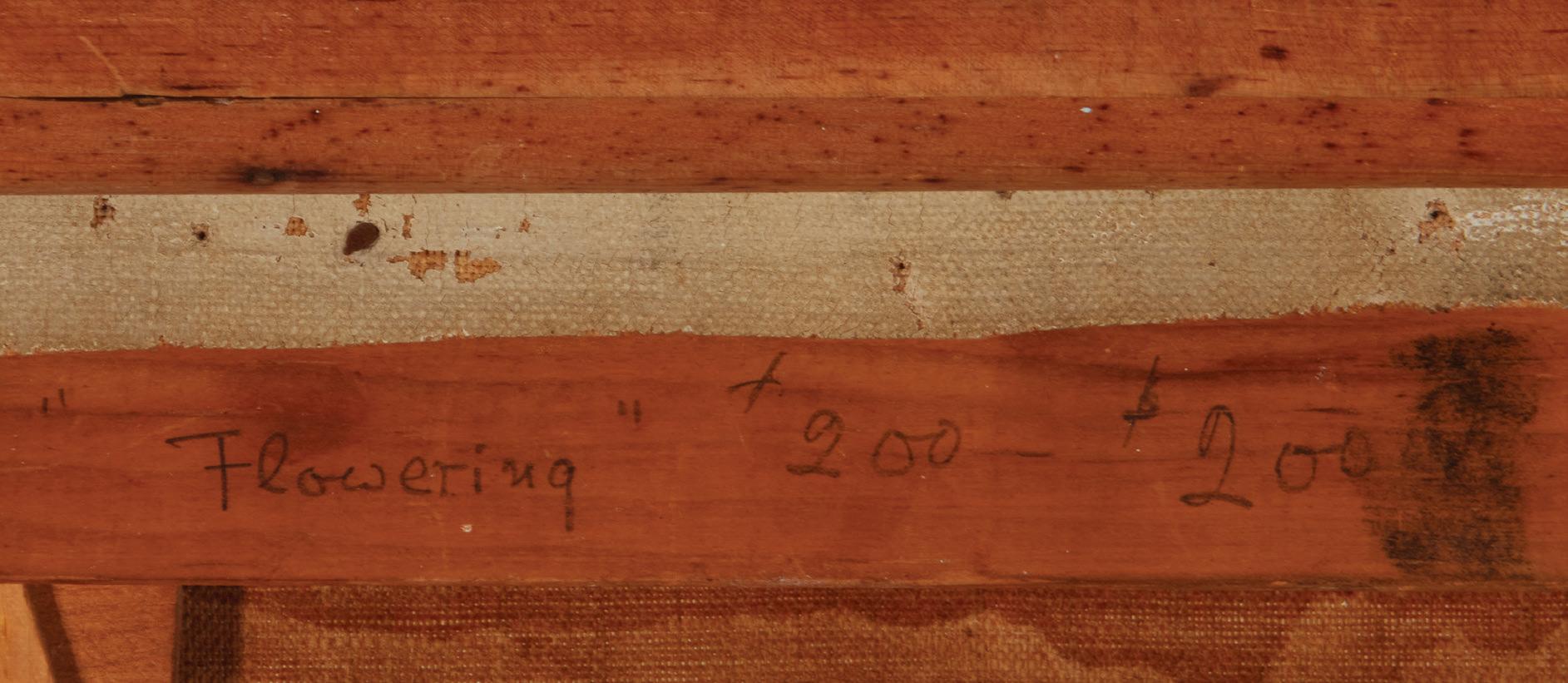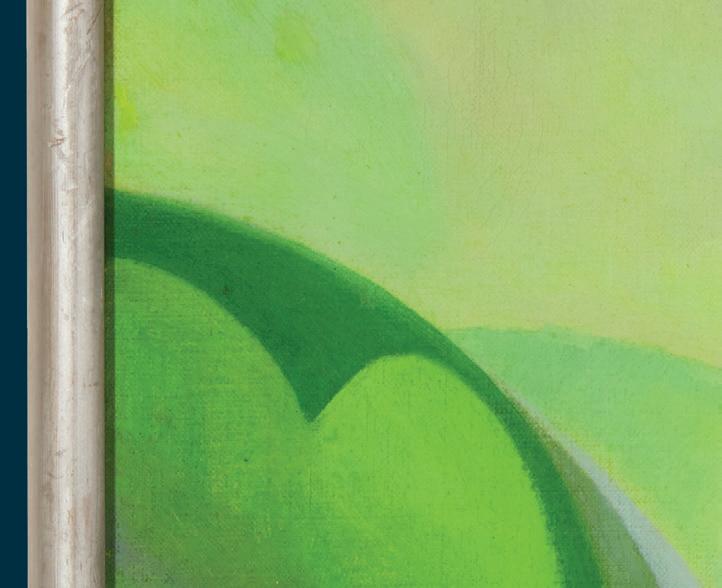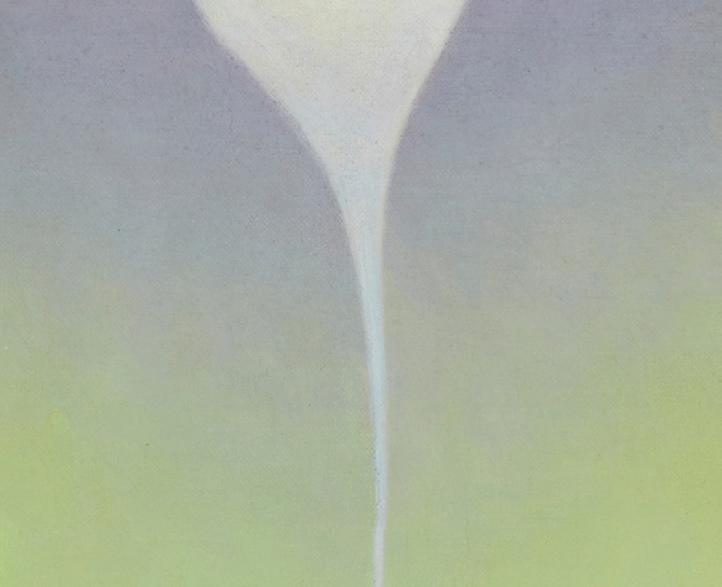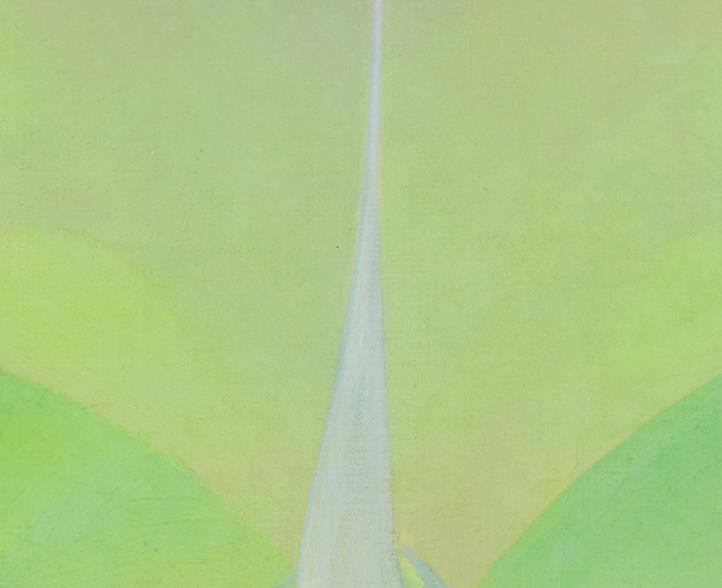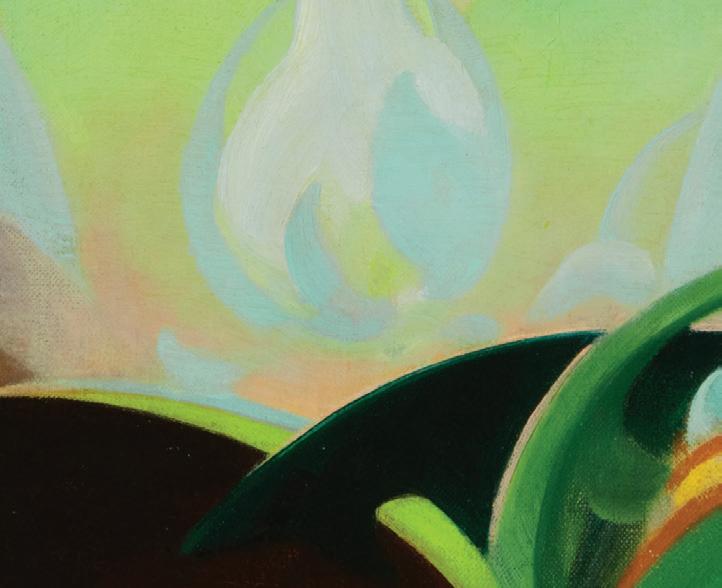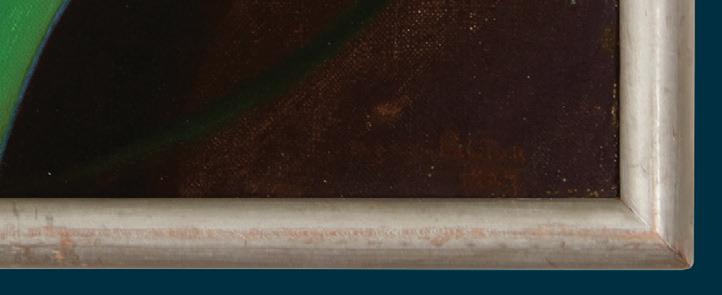

Featured in
Art + Design
August 13, 2024







"…the
miracles of growth day and night, the fountains of young green corn and the morning dew on the wild blueberries were a deep inspiration."
~Agnes Pelton


Agnes Pelton (1881-1961)
Flowering, 1929
Oil on canvas, 24 x 19 inches
Signed and dated lower right: Agnes Pelton; signed again, titled, and inscribed: “Water Mill Long Island N.Y. $200” (twice each), all in pencil on the upper and side stretcher bars; also with the stenciled number 452 on the upper stretcher bar
Housed in the artist’s original silver-grey painted frame
$300,000-500,000
Provenance:
The Artist
Matille Prigge “Billie” Seaman (1883-1966), neighbor and friend of Agnes Pelton
Josephine Morse True (1888-1975), neighbor and friend of Agnes Pelton, and author of the 1965 memoir, “Painted Rocks”
Estate of Anne-Marie Boyce, San Diego, CA, acquired from the above circa 1970s
Exhibited:
New York, NY, Montross Gallery, “Abstractions by Agnes Pelton,” November 11- 23, 1929, no. 12, Flowering. This solo exhibition included The Fountains, Caves of Mind, Star Gazer, Incarnation, Messenger, Lookouts, Ecstasy, Inward, Sleep, Being, Faith, Flowering, and Meadowlark’s Song – Winter.
Plainfield, NJ, Plainfield Public Library, “Exhibition of Paintings by Agnes Pelton,” March 16-30, 1931. This large solo exhibition consisted of thirty works: Peace, Being, The Fountains, Flowering, White Fire, Prayer, A Lotus For Lida, Sleep, Rose and Palm, Translation, Inward, Thought, Voyaging, Lookouts, In Winter, Radiance, Fire Sounds, Renunciation, Faith, Equilibrium, Ecstasy, Incarnation, Wells of Jade, Meadowlark’s Song – Winter, Star Icon No. 2, Hibiscus (Beirut, Syria), Windmill Path, 4 Hawaiian Flowers (decorative panels, samples for custom orders), Phantasy of Frost and Fire, Star Icon No.1.
Ogunquit, ME, Ogunquit Art Center, “9th Annual Exhibition of Painting & Etchings,” June 15July 30, 1931. This exhibition included Pelton’s Being and Flowering, according to Margaret Stainer, “Agnes Pelton” (Fremont: Ohlone College Art Gallery, 1989) page 33.
Andover, MA, Addison Gallery of American Art, Phillips Academy, “Third Loan Exhibition,” curated by Charles H. Sawyer, 1931 (specific months not known). This exhibition included Pelton’s Being and Flowering, according to Margaret Stainer, “Agnes Pelton” (Fremont: Ohlone College Art Gallery, 1989) page 33.
Brooklyn, NY, Brooklyn Society of Modern Artists, Painters & Sculptors Gallery, “Annual Exhibit,” March 1-13, 1932. This exhibition included Pelton’s Flowering and Ecstasy, according to Margaret Stainer, “Agnes Pelton” (Fremont: Ohlone College Art Gallery, 1989) page 33.

Literature:
Margaret Stainer, “Agnes Pelton,” (Fremont: Ohlone College Art Gallery, 1989) published to coincide with their exhibition October 9 - November 5, 1989. Clarifying note: In this publication curator Margaret Stainer provides chronological listings of select Pelton “Imaginative Paintings” dating from 1911 through 1917 and “Symbolic Abstractions” dating from 1923/24 through 1961. These are not checklists of works shown at Ohlone College in Stainer’s exhibition; they are incomplete “lifetime output” listings of Pelton paintings in these respective categories known to exist through archival sources and “best information” at the time of compilation and publication in 1989. Since that time, additional information has surfaced which expands and revises these lists. Stainer’s list of then-known Pelton abstractions for the year 1929 consisted of: Caves of Mind (De Anza College, Permanent Collection), Lookouts (unlocated), Messengers (Phoenix Art Museum, Permanent Collection), Frost and Fire (unlocated), Incarnation (Private Collection), Flowering, Alchemy (The Buck Collection at University of California Irvine), Ahmi in Egypt (Whitney Museum of American Art, Permanent Collection), The Voice (Burchfield Penney Art Center, Buffalo State University, Permanent Collection), White Fire (Raymond Jonson Collection, University of New Mexico), Sea Change (Whitney Museum of American Art, Permanent Collection), Shell (unlocated), Voyaging (JLW Collection), The Guide (Orange County Museum of Art, Permanent Collection), Bells (unlocated), Thought (unlocated), Efflorescent Decoration (unlocated).
Ed Garman, Posthumous inventory of Agnes Pelton’s abstractions, “Raymond Jonson Papers, University of New Mexico” no. 28 (circa 1961-62). Ed Garman (1914-2004) was a member of the Transcendental Painting Group.
Agnes Pelton papers, Archives of American Art, Smithsonian Institution, Notebook/ Sketchbook IV, circa 1917-1929; compositional sketch and color notes for Flowering appear on frame 95a (left-hand page) which bears a small swatch of muted greenish paint in the upper right quadrant; at the lower left quadrant of sketchbook 95b another swatch of paint, bright green, appears directly adjacent to the composition and color notes for Flowering on page 95a. Both a&b pages of frame 97 contain Pelton’s handwritten Montross Gallery exhibition hanging configurations which list Flowering among the works to be shown.
“The Art News,” volume 28, issue 7 (November 16, 1929); Volume 28, Issue 7; Exhibitions in New York, Agnes Pelton Montross Gallery; brief overview of Pelton’s Montross exhibition (no titles listed)
“An Exhibit of Paintings: Miss Pelton Making Display of Her Work in New York,” “Matawan Journal,” (November 15, 1929): page 2. This newspaper article provides titles of all works exhibited at Montross Gallery including Flowering.
Note: John Moran Auctioneers is grateful for the assistance from Mr. Michael Kelley in the research and cataloguing of this painting.
Rescue and Discovery
Unseen in public for nearly one hundred years and rescued from an estate clearance of items destined for donation to Mexico, Agnes Pelton's transcendental abstraction
Flowering represents a significant discovery by a pioneering American modernist. Her works have been acquired for the permanent collections of over two dozen American museums including MoMA NY, the Whitney Museum of American Art, the Crocker Art Museum, and the Los Angeles County Museum of Art.
The salvation of this striking and otherworldly painting is one in a series of fortuitous events bordering on the miraculous that have characterized the renaissance of interest in Agnes Pelton’s art which commenced in the early 1980s and continues to proliferate via museum exhibitions and acquisitions, catalogue publications, scholarly analysis, and public adulation.
Underscoring the rarity of Flowering’s discovery and offer for purchase is the fact that it is only the fifth Pelton transcendental abstraction to be offered at auction since the artist’s passing in 1961.
Flowering was conceived and painted by Agnes Pelton in August 1929 in her rural windmill home and studio located on Long Island, shortly after returning from an eight month visit to Southern California where she would move permanently in late 1931.

"…the miracles of growth day and night, the fountains of young green corn and the morning dew on the wild blueberries were a deep inspiration."
From “Windmill Home of Artist Inspires Unique Paintings” by Jane Corby, Brooklyn Daily Eagle, New York, Friday, February 20, 1931

Agnes Pelton standing in the doorway of her home and studio at Hayground Windmill (built 1809), Water Mill, Long Island, circa 1921.
Photo: Agnes Pelton papers, Archives of American Art, Smithsonian Institution

Flowering made its public debut in the exhibition Abstractions by Agnes Pelton, (November 11 - 23, 1929), at the Montross Gallery, New York City, in the company of The Fountains, Star Gazer, Being, Incarnation, Ecstasy, and Meadowlark’s Song –Winter, works which today are widely exhibited, reproduced, and the focus of ongoing scholarly analysis.
The Montross catalogue features an introduction written by Agnes Pelton which provides a glimpse into her creative mind and allows us to see Flowering through the lens of her visionary sensibilities:
“These pictures are like little windows, opening to the view of a region not yet much visited consciously or by intention—an inner realm, rather than an outer landscape. Sometimes the view is peaceful, even complete calm, or it may be active, stirring. Here color is like a voice, giving its message directly. Like music … it acts on the perception which is sympathetically ready to receive it. As the fragrance of a flower fills the consciousness with the essence of its life …by its own vibratory nature, with a beauty not for the eye alone, but of a more comprehensive nature, carrying a more direct impact on our newly developing perception.”
Excerpts from Agnes Pelton’s catalogue introduction ` , Montross Gallery, 1929.

The Montross exhibition was a life-changing event for Pelton. In addition to being an early solo showing of seminal abstract works, it is where she met music composer, philosopher, and fellow artist Dane Rudhyar (1895-1985) who became her close friend & mentor, astrologer, and chief art world advocate. Their decades-long friendship was of inestimable benefit to Pelton who revealed more of herself to Rudhyar, both personally and as an artist, than anyone else in her life. Through their relationship, Agnes was introduced to artist Raymond Jonson (1891-1982), with whom she exhibited in Santa Fe in 1933. This association led to Jonson, Pelton, and Rudhyar joining the New Mexico-based Transcendental Painting Group, for which Pelton also served as honorary president. The TPG’s philosophical and artistic alliance, forged “to carry painting beyond the appearance of the physical world,” was explored in the traveling survey Another World: The Transcendental Painting Group, curated by Michael Duncan. Today, some of the most perceptive and meaningful insights into Agnes Pelton and her art are those written by Dane Rudhyar:
“Her remarkable technique by means of which she produces an intense luminosity of color was acquired largely through her study of flowers” and is “the art of a woman of exquisite sensibility and awakened intuition who unveils through it an inner life rich in spiritual content.”
Dane Rudhyar, from his 1938 essay “The Transcendental Movement in Painting,” published in the exhibition catalogue Another World: The Transcendental Painting Group. (Crocker Art Museum, 2021)
“Agnes Pelton stands as the modern ‘seer’ type, unconnected to any particular school of philosophy, with the power to picture inwardly ‘bio-psychological’ symbols through which her inner development as a spiritual personality expresses itself in individual freedom.”
~Dane Rudhyar, quoted by Michael Duncan in Another World: The Transcendental Painting Group Crocker Art Museum, 2021

Dane Rudhyar (1895-1985)
In addition to the Montross show, Flowering was also exhibited at the Plainfield Public Library, New Jersey, 1931; the Ogunquit Art Center, Maine, 1931; the Addison Gallery of American Art, Massachusetts, 1931; and the Brooklyn Painters & Sculptors Gallery, New York, 1932.

Agnes Pelton’s handwritten price list featuring Flowering (entry #4) Plainfield Public Library exhibition, New Jersey, March 1931
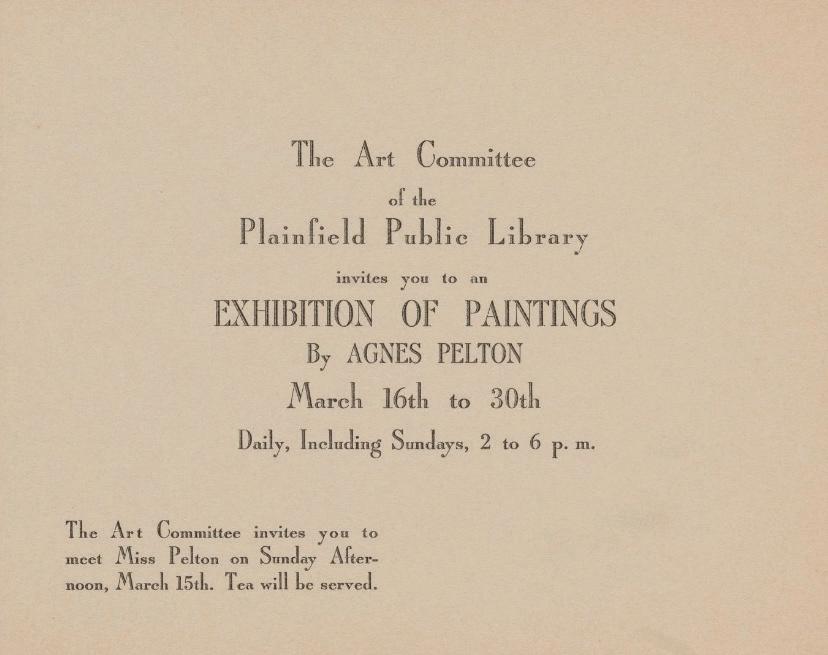
Announcement for Agnes Pelton’s 1931 solo show at Plainfield Public Library, New Jersey, in which Flowering was exhibited
Agnes Pelton held a deep Zen-like reverence for nature. An avid gardener with a love of flora, she understood from direct observation and hands-on experience the biodynamics of growth and wonders of bloom, which she perceived as symbolically reflective of universal truths found in humankind and the cosmos. In a 1926 newspaper interview, she seems to foretell her vision for Flowering while reminiscing that during the period from 1914 to 1918:
“came the war and raising vegetables with no time for painting but the miracles of growth day and night, the fountains of young green corn and the morning dew on the wild blueberries were a deep inspiration.”
The solitude and beauty provided by Pelton’s two homes of the period-- the windmill on Long Island and secluded farm in rural Connecticut-- were essential to her spiritual well-being and art making. She painted both representational and abstract compositions palpably influenced by these serene and picturesque environments, among which Flowering is a prime example.
“Pelton’s most imaginative works, including her exquisite organic abstractions, were always based on nature. Nature was the source of her life and art. …she was intrigued by the cycles of nature and the beauty of emerging life. To Pelton, life was most vibrant at the moment when it emerged…. The themes of emerging plant life, radiating light and youthful energy were Pelton’s personal leitmotifs. Later they became seminal elements in her mature abstractions.”
~ Michael Zakian, from his essay “Agnes Pelton Drawings“ in the exhibition catalogue of the same title, Ohlone College Art Gallery, 1996, curated by Margaret Stainer.

“As she gradually moved more and more toward abstraction, Pelton’s use of the floral image took on a deeper significance beyond the obvious bloom in nature. Even the early reviews of her flower paintings, which noted their carefully detailed representation, often indicated something more, something exotic, unknown, and powerful.”
~ Nancy Strow Sheley, from Bringing Light to Life: The Art of Agnes Pelton, University of Kansas, American Studies, 2000.
Pelton’s extensive world travels included visits to Italy, Paris, the Middle East, the American Southwest, various locales on both the East and West Coasts, and Hawaii. These experiences were fundamental to her acquisition of the botanical knowledge, creative vision, and refined artistic sensibilities requisite for producing exotic and richly symbolic compositions like Flowering. In considering this essential facet of Pelton’s evolution toward abstraction, Gilbert Vicario, curator of the exhibition Agnes Pelton, Desert Transcendentalist (Phoenix Art Museum & traveling, 2019-2021) observes,
“From 1921 to 1926, she traveled extensively to farflung places including lengthy stays in Hawaii and Syria, which afforded her firsthand knowledge of the seemingly contradictory landscapes and flora of these two diverse locales.”
~ Nancy Strow Sheley, from Bringing Light to Life: The Art of Agnes Pelton, University of Kansas, American Studies, 2000.
“Great
artists in all periods are those who incorporate in their works a new experience of reality.”
~ Dane Rudhyar’s catalogue introduction for Agnes Pelton’s 1931 exhibition at Argent Galleries, New York
‘‘…having left one place and not yet arrived in another is suggestive of the condition of mind which is open to such pictures as these.’’
~Agnes Pelton



In late 1931, Agnes Pelton moved from her windmill home on Long Island and relocated to Cathedral City, California, near Palm Springs, where she lived and painted for the next thirty years until her passing in 1961. Despite the harsh climate and sparse population, Pelton was deeply inspired by the desert environment and thrived artistically. The area became an enclave for those of a creative bent and was home to the Sven-Ska resort, a favorite stop for visiting artists, many of whom Pelton entertained. Landscape painter Matille “Billie” Seaman (1883-1966) and beekeeper-author Josephine Morse True (1888-1975), both former owners of Flowering, were residents of Cathedral City and neighbors of Pelton, as were husband-and-wife authors Irving Sussman (1908-1996) and Cornelia “Corinne” Sussman (1910-1999). The Sussmans held the honored distinction of being the caretakers of Pelton’s extensive archive which they donated to the Smithsonian’s Archives of American Art, providing an invaluable research resource that continues to be a wellspring of information for scholars.

Agnes Pelton regularly opened her home and studio to host salon-style teas and exhibitions of both her work and that of local artists. Welcoming a broad range of visitors consisting of neighbors and area residents, fellow artists and luminaries, relatives, children, and travelers from near and far, Pelton’s small residential gallery was the genesis for what eventually became the Desert Art Center which continues to operate in Palm Springs. The guestbook Pelton kept provides a fascinating window into her life and the small-town art world activities of Cathedral City during the 1940s and ‘50s and is now available to view online as part of the Smithsonian’s Agnes Pelton papers.

Author Josephine Morse True, neighbor of Agnes Pelton and former owner of Flowering, at her home in Imperial Beach, California, 1965 , holding a copy of her memoir “Painted Rocks”
Pelton’s Desire to Make “Living Art”
“She has treated the various items within the paintings in a way which seems to give them a life outside the purely physical.”~ Raymond Jonson, from his lecture “Three Paintings by Agnes Pelton,” University of New Mexico, circa 1939
With its themes of upward surging growth and blossoming unfoldment, Flowering is an example of Agnes Pelton consciously designing a picture with qualities intended to infuse it with the energies of a living creation. This conceptually advanced dynamic was noted by an anonymous author who reported in 1934 that Pelton
“...feels a new element has come into art with the moderns, namely the duration of time in a picture. This means that some part of the picture keeps on going like a fountain while you watch it. ‘The sensibilities are developing along lines in this air-minded age we were not aware of before,’ Miss Pelton explained.”
In Spiritual Moderns:Twentieth-Century American Artists and Religion (Chicago University Press, 2023), Erika Doss states that Pelton “…defined her Abstractions as animated entities-- expressing, becoming, leading, telling--engaged in an evolving ‘state of being.’ She saw them as living pictures: as vibrant images that embodied her spiritual thoughts and experiences, and possibly sparked similar awareness among viewers.”


Agnes Pelton’s notebook for years 1917-1929 containing her original sketch and notes for Flowering
“Agnes painted the invisible, which she tied to the natural world. She is the link between these two worlds, guided by her meditations.”
A fundamental dynamic of Pelton’s abstract compositions, as Margaret Stainer writes in her Agnes Pelton: Drawings catalogue essay (Ohlone College, 1996), was the desire to create spiritually transformative art. “Pelton was interested in the image as a window into another world, of color and forms that correspond poetically within the viewer. She is interested in life in nature… the soul in portraits… and in human correspondence to the physical and immanent energies surrounding us. She clothed her symbolic images, the abstractions, in the illusionistic language of atmospheric color and volumetric light that gave them depth and believable presence.”
In his essay Deep Streams Flow, Endlessly Renewing, Nathan Rees elaborates, “For Pelton, the appearance of creating and viewing art was central to its spiritual function. In her view, a work of art was not a physical repository of meaning so much as a nexus through which diverse interpretations brought by the artist and the viewer could converge. Pelton meant to do more than simply elicit a particular emotional response through her art—she considered the ‘inner realm’ from which she felt her paintings arose to be a fount of spiritual knowledge. The inner visions that she sought to portray were intended…to allow others, through the act of viewing, to access their own internal sight, awaken their own spiritual perception.” (American Religious Liberalism, edited by Leigh E. Schmidt and Sally M. Promby, Indiana University Press, 2012)
A notebook entry which appears a couple of pages after the annotated sketch for Flowering relates to the painting Star Gazer and reveals how spiritually invested Pelton was in the creation of her abstract compositions: “Oct. 19 (1929) After finishing Star Gazer - saw empty easel & felt light myself - empty - relieved, like an eggshell is empty - becoming a completeness in itself - with beauty - not just a covering for life within.”
AAA Notebook 1917-29 frame 97 (right page), two pages after entry for Flowering on frame 95
Flowering was designed to be a “living picture” that conveys a sense of movement and bioactivity. This is evidenced in Pelton’s 1929 sketchbook entry in which she drew side-by-side downward and upward facing arrows with the note “double action, down & up – transformed.”
Entries for Flowering appear in Notebook/Sketchbook IV, circa 1917-1929
Agnes Pelton papers, Archives of American Art, Smithsonian Institution
Frame: 95 (right page)
Transcription:
“Aug 18 [1929]
Flowering
[Double pencil sketch drawn below; left sketch is unframed and shows basic composition form; right sketch is framed (drawn) and forms are color-coded with numbers, size stated as 19 x 24 with notation indicating “Size of Ecstasy” (referring to another Pelton abstraction) ] Double action
down & up - transformed” [downward and upward arrows, drawn side-by-side]
Left column notes: “Background seawater or greenish ivory – close, like translucent fog – or steam in warmth [sic] light but dense- clearing toward top where it darkens slightly to blue violet gray – like blue agate. Mysterious rather than dense, just dark enough for flower to gleam & radiate against. Green, cream, gray-violet.”
Notes continue on right side of page with drawing of elongated floral form in-between: “Size of Ecstasy, 5 grayish [referring to color coded forms] green growth veg.[etation]
1 dark - thick
2 light virile green growth
Plunging down into
3 mysterious vaporous thick haze
4 reappearing upward more like green fire than vegetable surface
Delicate steam rising from them somewhat like smoke – tenuous in middle to pearly translucent flower open in center but not revealing light from top”

Notebook frame 97 (left and right pages): Pelton has made notes and diagrams for Montross Gallery exhibition layout options


“Agnes Pelton began her career as a painter of landscapes, portraits and above all flowers. The latter seem to have offered to her a natural transition to the realm of imaginative forms and exquisitely shaded colors. Flowers are, as it were, the climax of the plant’s effort toward the sun. And works of art like those of Miss Pelton are very much like the Flowering of an individual life. In practically all her works we witness a victory of light over darkness, and of life over death. They are psalms of integration sung to the spirit of man.”
In addition to philosophically-informed compositional content, Pelton’s methods of infusing her abstractions with “living” energies included the application of numerology and metaphysical color theory, both of which are pillars of Theosophy in which colors and numbers are believed to have vibrational frequencies that correspond to scientific principles and spiritual energies governing matter, states of consciousness, and aspects of the human psyche.
Pelton’s notebooks reveal a recurring focus on numbers. Entries range from details of complex numerical systems and examples of magic squares to calculations for determining canvas dimensions to align artworks with specific numerological attributes. In an entry from March 1929, written during her eight month stay in South Pasadena to study with Will Levington Comfort’s Theosophy-based “Glass Hive” group, a deeper agenda beyond appearances is expressed in Pelton’s observation that “All vibratory activity expresses itself in form, color and sound, the energy always of that particular color or shade belonging to that particular rate of vibration.” This quote is a closely paraphrased transcription of a passage from the 1927 publication “A Book About You” by Charles F. Haanel (1866-1949). Pelton’s awareness of and adherence to such principles suggests that the colors used for Flowering were selectively chosen for their metaphysical properties.
Agnes Pelton felt a deep connection with flowers and saw them as symbols of spiritual qualities that correlate with human life and personal transformation. With its intertwining forms, blooming energy and bio-luminescence, Flowering offers a portal for earthly, cosmic, and personal exploration.


